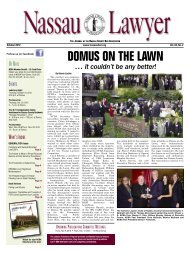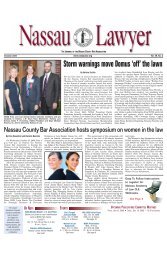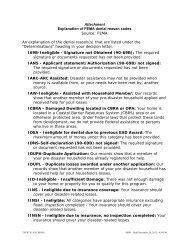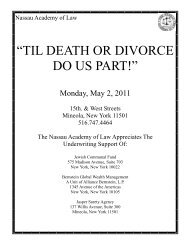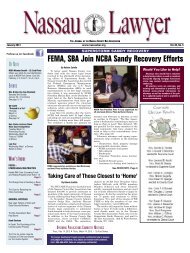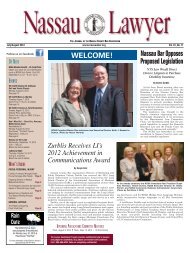770 N.Y.S.2d 421 Page 32 A.D.3d 780, 770 N.Y.S.2d 421, 2003 N.Y. Slip Op. 19961(Cite as: 2 A.D.3d 780, 770 N.Y.S.2d 421)fair consideration at a time when the person makingthe conveyance "intends or believes that he [or she]will incur debts beyond his [or her] ability to pay asthey mature, is fraudulent as to both present and futurecreditors." Pursuant to this constructive fraudprovision, a conveyance made by a person who has a"good indication <strong>of</strong> oncoming insolvency" is deemedto be fraudulent (Matter <strong>of</strong> Shelly v. Doe, 249 A.D.2d756, 758, 671 N.Y.S.2d 803). Here, however, takinginto account the rates charged by the facility at thetime the transfers were made, it cannot be said thatMrs. Witt had a "good indication" that the funds sheretained would be insufficient to pay for her nursinghome care during the three-year period she would berequired to wait in order to become eligible for Medicaidassistance (Matter <strong>of</strong> Shelly v Doe, supra; seeCase v. Fargnoli, 182 Misc.2d 996, 1001, 702N.Y.S.2d 764; see also Matter <strong>of</strong> John XX., 226A.D.2d 79, 652 N.Y.S.2d 329).2 A.D.3d 780, 770 N.Y.S.2d 421, 2003 N.Y. SlipOp. 19961END OF DOCUMENT[3] *782 Finally, we find no basis to set aside thetransfers pursuant to Debtor and Creditor <strong>Law</strong> § 276,which provides that "[e]very conveyance made * * *with actual intent * * * to hinder, delay, or defraudeither present or future creditors" is fraudulent. Whilecreditors may rely upon circumstantial factorsdeemed "badges <strong>of</strong> fraud" to establish an inference <strong>of</strong>fraudulent intent (White Rose Food v. Mustafa, 251A.D.2d 653, 654, 674 N.Y.S.2d 438; see Matter <strong>of</strong>Shelly v. Doe, supra; Pen Pak Corp. v. LaSalle Natl.Bank <strong>of</strong> Chicago, 240 A.D.2d 384, 658 N.Y.S.2d407), here the evidence submitted in support <strong>of</strong> themotion demonstrated that Mrs. Witt retained assetsreasonably calculated to cover the cost <strong>of</strong> her care forthe three-year period she would be required to waituntil she became eligible for Medicaid benefits. Althoughthe plaintiff contends that this conduct wasfraudulent, at the time the transfers were made, nopenalty could be imposed upon an individual fortransferring assets more than three years before**424 his or her application for Medicaid (see Matter<strong>of</strong> John XX., supra ). Under these circumstances,Mrs. Witt's decision to make gifts to her family whileretaining assets reasonably calculated to cover thecost <strong>of</strong> her care until she became eligible to receiveMedicaid assistance cannot be considered acts <strong>of</strong>intentional fraud against future creditors (see Matter<strong>of</strong> John XX., supra; see also Matter <strong>of</strong> Shah, 257A.D.2d 275, 283, 694 N.Y.S.2d 82, affd. 95 N.Y.2d148, 711 N.Y.S.2d 824, 733 N.E.2d 1093).© 2009 Thomson Reuters. No Claim to Orig. US Gov. Works.
Page 14 A.D.3d 495, 773 N.Y.S.2d 71, 2004 N.Y. Slip Op. 01149(Cite as: 4 A.D.3d 495, 773 N.Y.S.2d 71)Westlaw Delivery Summary Report for DANIELS,JEFFREYYour Search:Dempster v Overview EquitiesDate/Time <strong>of</strong> Request:Friday, October 23, 2009 08:49 EasternClient Identifier:ACADEMY OF LAWDatabase:NY-CSCitation Text: 4 A.D.3d 495Lines: 217Documents: 1Images: 0The material accompanying this summary is subject to copyright. Usage is governed by contract with ThomsonReuters, West and their affiliates.[1] Judgment 228 185(2)Supreme Court, Appellate Division, Second Department,New York.Madeline DEMPSTER, respondent,v.OVERVIEW EQUITIES, INC., et al., defendants,Island Helicopter Leasing Corp., et al., appellants.Feb. 23, 2004.Background: Former wife brought fraudulent actionagainst former husband's businesses to enforceamended judgment <strong>of</strong> divorce, granting her additionalequitable distribution amounts, based upon value <strong>of</strong>former husband's businesses. The Supreme Court,<strong>Nassau</strong> County, Skelos, J., granted summary judgmentin favor <strong>of</strong> former wife.Holdings: The Supreme Court, Appellate Division,held that:(1) former wife established that conveyance <strong>of</strong> formerhusband's residence to his closely held businesswas fraudulent, supporting award <strong>of</strong> additional equitabledistribution amounts, and(2) doctrines <strong>of</strong> collateral estoppel and res judicatadid not bar litigation <strong>of</strong> issue <strong>of</strong> whether promissorynotes in favor <strong>of</strong> businesses constituted fair considerationto support former husband's confession <strong>of</strong>judgement in favor <strong>of</strong> businesses.Affirmed.West Headnotes228 Judgment228V On Motion or Summary Proceeding228k182 Motion or Other Application228k185 Evidence in General228k185(2) k. Presumptions and Burden<strong>of</strong> Pro<strong>of</strong>. Most Cited CasesA party moving for summary judgment must make aprima facie showing <strong>of</strong> entitlement to judgment as amatter <strong>of</strong> law, <strong>of</strong>fering sufficient evidence to demonstratethe absence <strong>of</strong> any triable issue <strong>of</strong> fact.[2] Divorce 134 275(2)134 Divorce134V Alimony, Allowances, and Disposition <strong>of</strong>Property134k260 Enforcement <strong>of</strong> Order, Judgment, orDecree134k275 Conveyance in Fraud <strong>of</strong> Spouse'sRights134k275(2) k. Transfers and TransactionsInvalid. Most Cited CasesFormer wife established that conveyance <strong>of</strong> formerhusband's residence to his closely held business wasfraudulent, supporting award <strong>of</strong> additional equitabledistribution amounts based upon valuation <strong>of</strong> business;business to which residence was transferred wascreated just two days before transfer, transfer wasmade just before valuation trial to value former husband'sbusiness interests for equitable distributionpurposes, valuation trial could have rendered residenceas valid target <strong>of</strong> equitable distribution, and© 2009 Thomson Reuters. No Claim to Orig. US Gov. Works.
- Page 1 and 2:
Nassau Academy of LawCLE Live Class
- Page 3 and 4:
McKinney's Debtor and Creditor Law
- Page 5 and 6:
McKinney's Debtor and Creditor Law
- Page 7 and 8:
McKinney's Debtor and Creditor Law
- Page 9 and 10:
McKinney's Debtor and Creditor Law
- Page 11 and 12:
McKinney's Debtor and Creditor Law
- Page 13 and 14:
McKinney's Debtor and Creditor Law
- Page 15 and 16:
McKinney's Debtor and Creditor Law
- Page 17 and 18:
McKinney's Debtor and Creditor Law
- Page 19 and 20:
BAKER & HOSTETLER LLP45 Rockefeller
- Page 21 and 22:
usiness of defendant Bernard L. Mad
- Page 23 and 24:
BACKGROUND, THE TRUSTEE, AND STANDI
- Page 25 and 26:
Madoff who received fraudulent tran
- Page 27 and 28:
ased on fictitious profits and for
- Page 29 and 30:
28. BLMIS funds were also used to p
- Page 31 and 32:
Madoff, and her niece, Shana Madoff
- Page 33 and 34:
42. Ruth Madoff was never an employ
- Page 35 and 36:
FIRST CAUSE OF ACTIONTURNOVER AND A
- Page 37 and 38:
66. At the time of each of the Two-
- Page 39 and 40:
Transfers; (b) directing that the S
- Page 41 and 42:
EIGHTH CAUSE OF ACTIONUNDISCOVERED
- Page 43 and 44:
TENTH CAUSE OF ACTIONDISALLOWANCE O
- Page 45 and 46:
111. Mrs. Madoff benefited from the
- Page 47 and 48:
WHEREFORE, the Trustee respectfully
- Page 49 and 50:
2(c)(3): (a) preserving the Subsequ
- Page 51 and 52:
302 B.R. 760 Page 1302 B.R. 760(Cit
- Page 53 and 54:
302 B.R. 760 Page 3302 B.R. 760(Cit
- Page 55 and 56:
302 B.R. 760 Page 5302 B.R. 760(Cit
- Page 57 and 58:
302 B.R. 760 Page 7302 B.R. 760(Cit
- Page 59 and 60:
302 B.R. 760 Page 9302 B.R. 760(Cit
- Page 61 and 62:
302 B.R. 760 Page 11302 B.R. 760(Ci
- Page 63 and 64:
302 B.R. 760 Page 13302 B.R. 760(Ci
- Page 65 and 66:
302 B.R. 760 Page 15302 B.R. 760(Ci
- Page 67 and 68:
302 B.R. 760 Page 17302 B.R. 760(Ci
- Page 69 and 70:
302 B.R. 760 Page 19302 B.R. 760(Ci
- Page 71 and 72:
394 B.R. 721 Page 1394 B.R. 721, 50
- Page 73 and 74:
394 B.R. 721 Page 3394 B.R. 721, 50
- Page 75 and 76: 394 B.R. 721 Page 5394 B.R. 721, 50
- Page 77 and 78: 394 B.R. 721 Page 7394 B.R. 721, 50
- Page 79 and 80: 394 B.R. 721 Page 9394 B.R. 721, 50
- Page 81 and 82: 394 B.R. 721 Page 11394 B.R. 721, 5
- Page 83 and 84: 394 B.R. 721 Page 13394 B.R. 721, 5
- Page 85 and 86: 394 B.R. 721 Page 15394 B.R. 721, 5
- Page 87 and 88: 394 B.R. 721 Page 17394 B.R. 721, 5
- Page 89 and 90: 394 B.R. 721 Page 19394 B.R. 721, 5
- Page 91 and 92: 394 B.R. 721 Page 21394 B.R. 721, 5
- Page 93 and 94: 397 B.R. 642 Page 2397 B.R. 642(Cit
- Page 95 and 96: 397 B.R. 642 Page 4397 B.R. 642(Cit
- Page 97 and 98: 397 B.R. 642 Page 6397 B.R. 642(Cit
- Page 99 and 100: 397 B.R. 642 Page 8397 B.R. 642(Cit
- Page 101 and 102: 397 B.R. 642 Page 10397 B.R. 642(Ci
- Page 103 and 104: 397 B.R. 642 Page 12397 B.R. 642(Ci
- Page 105 and 106: 397 B.R. 642 Page 14397 B.R. 642(Ci
- Page 107 and 108: 443 F.3d 180 Page 2443 F.3d 180(Cit
- Page 109 and 110: 443 F.3d 180 Page 4443 F.3d 180(Cit
- Page 111 and 112: 443 F.3d 180 Page 6443 F.3d 180(Cit
- Page 113 and 114: 443 F.3d 180 Page 8443 F.3d 180(Cit
- Page 115 and 116: 443 F.3d 180 Page 10443 F.3d 180(Ci
- Page 117 and 118: 443 F.3d 180 Page 12443 F.3d 180(Ci
- Page 119 and 120: Page 2257 A.D.2d 526, 684 N.Y.S.2d
- Page 121 and 122: Page 4257 A.D.2d 526, 684 N.Y.S.2d
- Page 123 and 124: Page 6257 A.D.2d 526, 684 N.Y.S.2d
- Page 125: 770 N.Y.S.2d 421 Page 22 A.D.3d 780
- Page 129: Page 34 A.D.3d 495, 773 N.Y.S.2d 71
- Page 132 and 133: 780 N.Y.S.2d 409 Page 29 A.D.3d 553
- Page 134 and 135: Page 134 A.D.3d 231, 824 N.Y.S.2d 3
- Page 136 and 137: Page 334 A.D.3d 231, 824 N.Y.S.2d 3
- Page 138 and 139: Page 2991 F.2d 31(Cite as: 991 F.2d
- Page 140 and 141: Page 4991 F.2d 31(Cite as: 991 F.2d
- Page 142 and 143: Page 6991 F.2d 31(Cite as: 991 F.2d
- Page 144 and 145: FRAUDULENT TRANFERENCESRonald M. Te
- Page 146 and 147: Nursing home case_ Transfer of pers
- Page 148 and 149: Sections 548 and 544 work in concer
- Page 150 and 151: U.S. Supreme CourtBFP v. Resolution
- Page 152 and 153: example, from net 15 to COD; or cha
- Page 154 and 155: Bankruptcy Code Section§ 548. Frau
- Page 156: Ron Terenzi is a founding partner a



